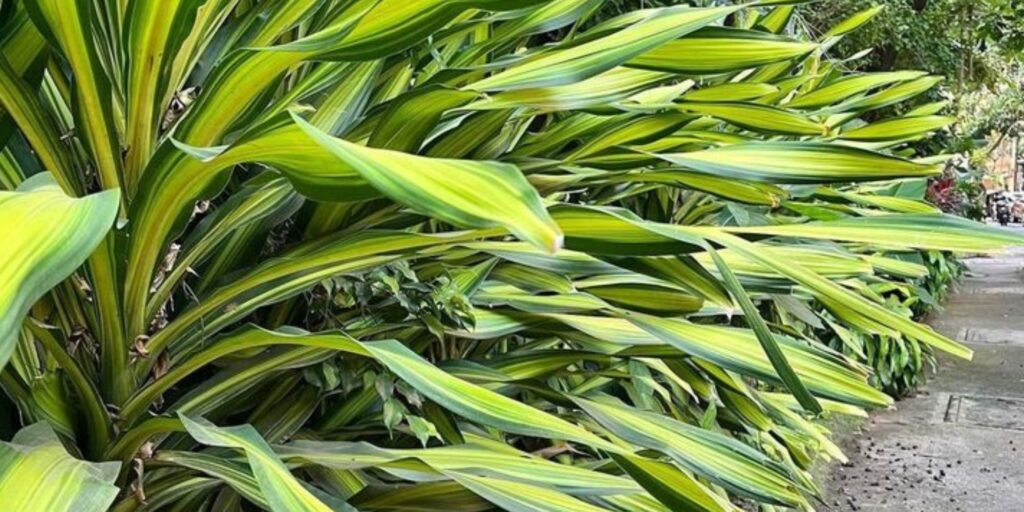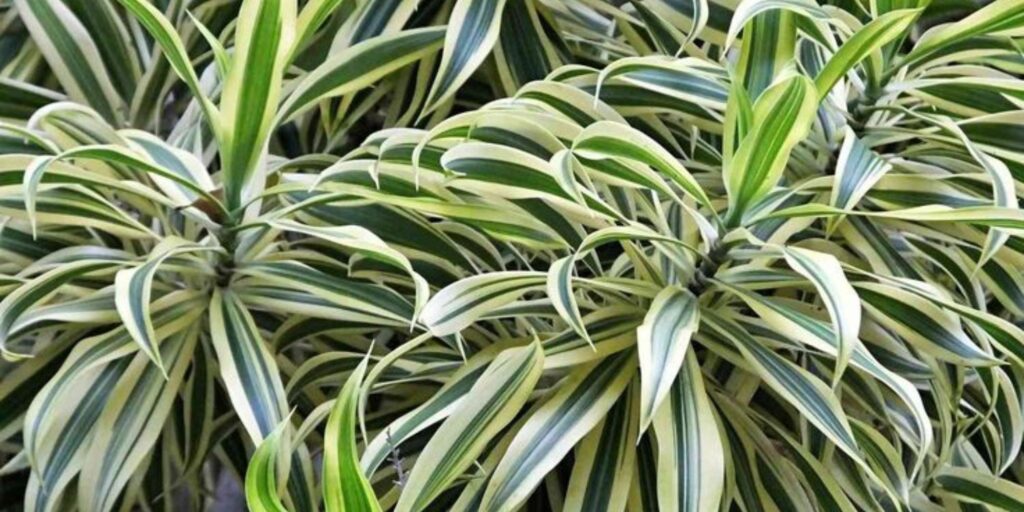How to Grow and Care for Dracaena Plants
The Dracaena plant is a versatile and low-maintenance houseplant, known for its striking appearance and ability to thrive in various indoor environments. With its long, narrow leaves that can range from deep green to vibrant red and yellow, it adds a touch of elegance and color to any room. Dracaenas are adaptable to low or indirect light, making them ideal for spaces with minimal natural sunlight. These plants require only occasional watering, as they are drought-tolerant and prefer well-draining soil. Many Dracaena varieties grow into small trees, reaching heights of up to 6 feet, making them a bold statement piece in any home or office. In addition to their beauty, Dracaenas are also effective at purifying indoor air by removing harmful toxins. Whether you’re new to plant care or an experienced gardener, the Dracaena is a perfect choice for anyone looking to enhance their space with minimal effort.
Dracaena Plant :Introduction

If you’re looking to add a touch of greenery to your home or office, the Dracaena plant is an excellent choice. With its striking foliage and low-maintenance nature, it’s no wonder that this plant has become incredibly popular among indoor gardeners. From the elegant Dracaena marginata to the bold Dracaena fragrans, there’s a variety for every style and space.
Caring for these plants can be easy if you know what they need. This ultimate guide will take you through everything from planting tips to troubleshooting common issues. Whether you’re a seasoned gardener or just starting, we’ve got all the information you need to ensure your Dracaena thrives! Let’s dig into how to create an ideal environment for your new leafy friend.
Understanding Dracaena Plant
Dracaena plants are a popular choice for home and office decor, thanks to their striking foliage and easy care. There are several types of Dracaena, including the well-known Dracaena marginata with its slender stems and vibrant leaves, and the lush Dracaena fragrans that can grow quite tall. Each variety brings its unique charm.
These plants belong to the Asparagaceae family. They thrive in various environments, making them versatile companions for plant lovers. Understanding their characteristics helps foster an appreciation for these resilient beauties as they adapt seamlessly to indoor spaces.
Types of Dracaena Plant
Dracaena plants boast a diverse range of species, each with unique characteristics. Popular varieties include the Dracaena marginata, known for its slender stems and vibrant green leaves edged in red. Another favorite is the Dracaena fragrans, or corn plant, admired for its thick stalks and lush foliage.
Other intriguing types include the striking Dracaena sanderiana, often called lucky bamboo, and the eye-catching Dracaena surculosa with its speckled leaves. Each type adds a different flair to your indoor garden while maintaining low maintenance needs.
Dracaena Plant Family Profile
Dracaena plants belong to the Asparagaceae family, boasting a diverse range of species and varieties. This makes them not only visually appealing but also versatile for different indoor settings. Their striking foliage can elevate any room’s aesthetic.
These tropical evergreens are native to Africa, Asia, and Central America. They thrive in various environments, making them a popular choice among plant enthusiasts. With their unique leaf shapes and colors, Dracaena plants serve as fantastic focal points in home decor while requiring minimal maintenance.
Caring for Your Dracaena Plant

To care for your Dracaena, start by choosing the right soil and pot. Use a well-draining mix to prevent root rot. Water when the top inch of soil feels dry, ensuring that excess moisture can escape.
Temperature and humidity play crucial roles in a healthy Dracaena. Keep it in bright, indirect light but avoid direct sunlight to protect its leaves. Fertilize every few months during the growing season with a balanced liquid fertilizer for optimal growth. Regularly check for signs of stress or nutrient deficiencies to keep your plant thriving.
Planting and Growing Tips
When planting your Dracaena, choose well-draining soil and a pot with drainage holes. This allows excess water to escape, preventing root rot. Ensure the container is slightly larger than the root ball for optimal growth.
Water your Dracaena thoroughly after planting, then allow the top inch of soil to dry before watering again. This balance helps establish strong roots while avoiding overwatering. Position your plant in a spot with indirect light; too much sun can scorch its leaves. A little attention goes a long way in nurturing this resilient beauty!
Dracaena Plant :Temperature, Humidity, and Light Requirements
Dracaena plants thrive in warm environments, preferring temperatures between 65°F and 80°F. They are sensitive to extreme cold; keep them away from drafts or sudden temperature changes.
Humidity levels should ideally be moderate to high. While they can adapt to lower humidity, providing extra moisture through misting or a pebble tray can enhance their vitality. When it comes to light, bright indirect sunlight is best. Too much direct sunlight can scorch the leaves while too little light may hinder growth, so find that sweet spot for your dracaena plant’s happiness!
Fertilizing Your Dracaena Plant
Fertilizing your Dracaena plant is crucial for its health and growth. Use a balanced liquid fertilizer every four to six weeks during the growing season, typically spring through summer. Dilute it to half-strength to avoid overwhelming the roots.
In fall and winter, reduce feeding as the plant’s growth slows down. Always ensure that you water your Dracaena before applying fertilizer; this helps prevent root burn. Observing your plant’s response will guide future fertilization decisions, ensuring it remains vibrant and flourishing throughout the year.
Pruning Techniques
Pruning your Dracaena plant is essential for maintaining its shape and encouraging healthy growth. Focus on removing any dead or yellowing leaves, as they can drain energy from the plant. Use clean, sharp scissors to make precise cuts.
For a fuller appearance, trim back longer stems just above a leaf node. This encourages new growth while keeping the overall structure balanced. Regular pruning not only enhances aesthetics but also helps prevent pest infestations by increasing air circulation around the foliage.
Propagating Dracaena
Propagating a Dracaena plant is quite simple and rewarding. You can easily do this through stem cuttings or by division. For stem cuttings, select a healthy section of the stem, ideally around six inches long, and remove it just below a node. Place it in water or well-draining soil until roots develop.
If you prefer division, carefully separate the offsets from the main plant during repotting. Ensure each offset has some roots attached for better survival chances. With proper care and patience, your new Dracaena will thrive alongside its parent plant.
Potting and Repotting
Potting and repotting your Dracaena plant is essential for its growth. When you notice roots emerging from the drainage holes or if the soil dries out too quickly, it’s time to make a change. Choose a pot that’s one size larger with good drainage.
Use a well-draining potting mix specifically formulated for houseplants. Gently remove your Dracaena from its current pot, taking care not to damage the roots. Place it in the new container, and fill in around the sides with fresh soil, and water thoroughly to help settle the plant into its new home.
Common Issues and Solutions
Dracaena plants, while generally hardy, can face challenges. Pests like spider mites and mealybugs may invade your greenery. Regular inspection helps catch these problems early. Consider using insecticidal soap as a safe treatment option.
Leaves might show distress in various ways. Browning edges often signal underwatering or low humidity, while yellowed leaves could indicate overwatering or nutrient deficiencies. If droopy leaves appear, check the soil moisture level; it might be time to adjust your watering routine. Scorched leaves usually mean too much direct sunlight—relocate your plant to a brighter but indirect light spot for relief.
Dealing with Pests and Diseases
Pests and diseases can pose a threat to your Dracaena plant. Common pests include spider mites, mealybugs, and scale insects. Regularly inspect the leaves and stems for any signs of infestation. If you spot pests, use insecticidal soap or neem oil to treat them effectively.
Diseases like root rot often stem from overwatering. Ensure proper drainage and avoid letting the roots sit in water. Yellowing leaves may indicate fungal issues; removing affected parts can help prevent further spread. Maintaining good airflow around your plant is crucial for overall health too.
Troubleshooting Common Problems:
Browning leaves on a Dracaena plant usually indicate underwatering or low humidity. Ensure your plant receives enough moisture, and consider using a humidifier if the air is too dry. Regular misting can also help revive those crispy edges.
Yellowed leaves may signal overwatering or nutrient deficiencies. Check the soil’s moisture level before watering again, and consider feeding with a balanced fertilizer to boost health. Droopy leaves often mean your plant needs more light or water; adjust its location accordingly for optimal growth. Scorched leaves typically result from direct sunlight exposure—relocate them to indirect light for better results.
Browning Leaves
Browning leaves on your Dracaena plant can be a source of concern. This issue often arises from underwatering or inconsistent watering schedules. The tips may turn brown and crispy, signaling that the plant is stressed.
Another common cause is exposure to direct sunlight. Dracaenas prefer bright, indirect light. If they receive too much sun, their leaves will start to burn. Adjusting the lighting conditions and ensuring proper watering can help revive your plant’s health.
Yellowed Leaves
Yellowed leaves on your Dracaena plant can be a sign of various issues. One common cause is overwatering, which leads to root rot. If the roots sit in soggy soil for too long, they struggle to absorb nutrients effectively.
Another reason for yellowing could be inadequate light. Dracaenas prefer bright, indirect sunlight. If they’re placed in low-light conditions, their leaves may start to lose color and vitality. Adjusting their location or watering routine can help restore their health and vibrancy.
Droopy Leaves
Droopy leaves on your Dracaena plant can signal several underlying issues. Often, this symptom indicates overwatering or underwatering. Check the soil’s moisture level; if it feels soggy, reduce watering frequency.
Additionally, consider your plant’s environment. Low humidity or sudden temperature changes may also contribute to drooping leaves. Make adjustments by relocating your Dracaena to a more stable area with consistent conditions and adequate humidity levels for optimal growth. Regularly monitor these factors to keep your plant vibrant and healthy.
Scorched Leaves
Scorched leaves on your Dracaena plant can be alarming. This usually occurs due to excessive sunlight exposure or high temperatures. If you notice brown tips and crispy edges, it’s essential to evaluate the plant’s environment.
To remedy this issue, consider relocating your Dracaena to a shadier spot where it receives indirect light. Additionally, check if the temperature is consistently above 75°F (24°C). Adjusting these factors will help revive your plant’s health and restore its lush appearance over time.
Additional Tips and Tricks

To keep your Dracaena plant thriving, rotate it every few weeks. This helps ensure even growth as it reaches for light. Consider using a pebble tray filled with water to boost humidity, especially in dry climates.
Another handy tip is to wipe the leaves occasionally with a damp cloth. This removes dust and allows the plant to breathe better. Remember that Dracaenas can adapt well, so if you notice slow growth or other changes, be patient and adjust care accordingly without worrying too much right away.
Conclusion
Caring for your Dracaena plant can transform your living space into a lush oasis. By understanding the specific needs of this resilient houseplant, you can ensure it thrives in your home. From choosing the right type to addressing common issues, each step plays a vital role in its health and beauty.

